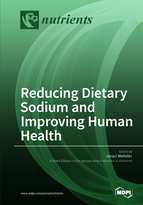Reducing Dietary Sodium and Improving Human Health
A special issue of Nutrients (ISSN 2072-6643).
Deadline for manuscript submissions: closed (15 June 2017) | Viewed by 201833
Special Issue Editor
2. Food Policy Division, The George Institute for Global Health, Sydney, Australia
Interests: salt/sodium; dietary interventions; nutrition surveillance; food policy; advocacy; research translation; public health
Special Issue Information
Dear Colleagues,
This Special Issue of Nutrients, entitled “Reducing Dietary Sodium and Improving Human Health”, welcomes the submission of manuscripts either describing original research or reviewing scientific literature related to salt reduction. Manuscripts should focus on population interventions for reducing dietary sodium and we are particularly interested in innovative approaches to changing the food environment and/or consumer behaviour. Manuscripts that discuss theoretical models informing the design of interventions for reducing dietary sodium are also welcome, as are studies from low or lower middle income countries.
Potential topics may include, but are not limited to:
- Development/evaluation of regional or national strategies to reduce population salt intake
- Methodological issues related to measuring salt consumption patterns
- Use of policy or legislative approaches to reduce salt consumption
- Design and/or assessment of impact of behavioural change programs
- Modelling of the impact of interventions on salt intake and health outcomes
Dr. Jacqui Webste
Guest Editor
Manuscript Submission Information
Manuscripts should be submitted online at www.mdpi.com by registering and logging in to this website. Once you are registered, click here to go to the submission form. Manuscripts can be submitted until the deadline. All submissions that pass pre-check are peer-reviewed. Accepted papers will be published continuously in the journal (as soon as accepted) and will be listed together on the special issue website. Research articles, review articles as well as short communications are invited. For planned papers, a title and short abstract (about 100 words) can be sent to the Editorial Office for announcement on this website.
Submitted manuscripts should not have been published previously, nor be under consideration for publication elsewhere (except conference proceedings papers). All manuscripts are thoroughly refereed through a single-blind peer-review process. A guide for authors and other relevant information for submission of manuscripts is available on the Instructions for Authors page. Nutrients is an international peer-reviewed open access semimonthly journal published by MDPI.
Please visit the Instructions for Authors page before submitting a manuscript. The Article Processing Charge (APC) for publication in this open access journal is 2900 CHF (Swiss Francs). Submitted papers should be well formatted and use good English. Authors may use MDPI's English editing service prior to publication or during author revisions.
Keywords
- salt
- sodium
- population interventions
- behaviour change
- food environment
- evaluation
- health outcomes
- policy







